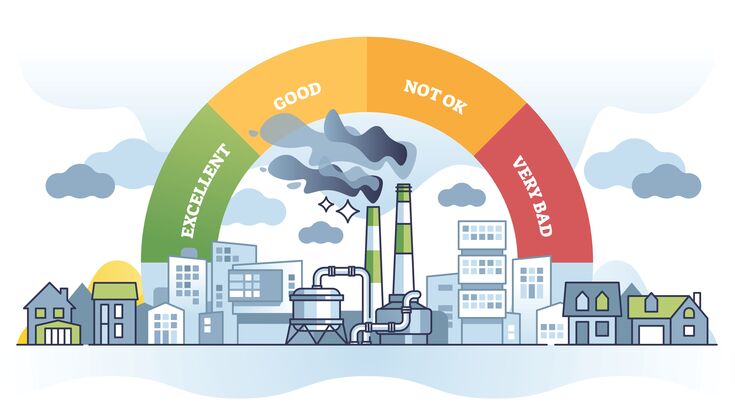Waste to Energy : New SWANA report on advanced air pollution control options for WtE

The Applied Research Foundation (ARF) of the Solid Waste Association of North America (SWANA) has released a new report, Advanced Air Pollution Control at Waste-to-Energy Facilities. This report offers a state-of-the-art review - complemented by case studies - of commercially proven, new and emerging nitrogen oxide (NOX) and carbon dioxide (CO2) control technologies that can potentially be used at existing WtE facilities.
Over the last 30 years, thanks to an investment of about 1 billion US dollars in air pollution control systems, the sector was able to significantly reduce its emissions.
It is SWANA’s hope that this report will serve as a valuable and timely reference document for WtE facility managers as they consider the benefits and costs of investing in additional NOX control technologies and CO2 capture systems to further reduce emissions from their facilities. The report also serves as a useful resource for state and local government officials evaluating WTE facilities.
Jeremy O’Brien, SWANA’s Director of Applied Research, talks with Waste Management World about the legal requirements for emissions control, the key findings of the report and the future of the sector.
Which technologies were examined for this report? Which are the most commonly used ones so far?
If modifying the combustion process cannot sufficiently reduce NOx emissions to meet MACT standards, then air pollution control equipment needs to be utilized to achieve the required emission levels. The two major types of air pollution control (APC) equipment that can be utilized for this purpose are:
- Selective-Non-Catalytic-Reduction (SNCR) technology, including Advanced SNCR and
- Selective-Catalytic-Reduction (SCR) technology.
In a 2016 survey of WtE facilities in Europe, SNCR was used in 170 flue gas cleaning process lines while SCR was utilized in 133 process lines and a combination of SNCR and SCR was used in 19 process lines.[1] In the U.S. virtually all WtE facilities use SNCR for NOx control; only one uses the SCR technology.

Can you tell us something about the most important findings?
Over the last thirty years, the WtE industry in the U.S. has made very significant progress in reducing emissions from the combustion of municipal solid waste. Emissions of seven pollutants (including dioxins and furans) have been reduced on average by 95% of their 1990 emissions while NOx emissions have been reduced by an estimated 44%. Emissions of the seven pollutants are less than 30% of their permitted values, while NOx emissions are less than 70%. Emissions from the newest WtE facility constructed in the U.S.— the Palm Beach Renewable Energy Facility No. 2 in Palm Beach County—are among the lowest of any WtE facility in the world.
Despite these accomplishments, WtE plant managers face increasing pressure to reduce NOx and CO2 emissions from their facilities. A major reason for this pressure is that these facilities often represent one of the largest point sources of NOx and CO2 emissions in their host communities as WtE are sited closer to population centers to reduce overall waste transportation/processing costs.
This report provides a state-of-the-art review— supplemented by case studies—of NOx and CO2 control technologies that WtE facility managers can use as a reference as they consider the implementation of these technologies at their facilities. In this regard, the significant costs associated with the NOx reduction technologies – especially the SCR - should be weighed against the potential economic impact of WtE remaining a critical component of the solid waste management infrastructure and the minimal impact that additional WtE NOx reductions may have on local air quality when compared to NOx emissions from the transportation sector.
The cost-benefits of the WtE NOx reduction options should also be considered in light of other NOx reduction strategies, such as conversion to electric vehicles, that may be more cost-effective. Finally, while post-combustion carbon capture may have the most potential for application on WtE facilities it is still in the early stage of commercialization and large-scale applications need to be technically and economically demonstrated. Further, considering the significant capital and costs and uncertain economic benefits with the implementation of CCS, the technology may need subsidies to make it viable and will be especially dependent on the development of costly large-scale public infrastructure for the transport and storage of CO2 if captured CO2 cannot be fully utilized.
Interested in industry updates? Subscribe to our newsletters!
While post-combustion carbon capture may have the most potential for application on WtE facilities it is still in the early stage of commercialization and large-scale applications need to be technically and economically demonstrated.Jeremy O'Brien
Can you recap the legal requirements for emission reductions and what a revised MACT might have in store for WtE?
The MACT NOx emissions limits for existing large municipal waste combustors are presented in Table 3-1. As indicated, U.S. limits differ based on the type of WtE facility being regulated. States have the right to promulgate lower limits than the federal MACT standards.
The emission limit for NOx of 200 mg/Nm3 (137 ppm @7%O2) has been in force for new European plants since the year 2000 and for existing plants from the end of 2005. In some European countries a lower emission limit has been introduced. In Austria and Switzerland, the NOx limit is 80 mg/Nm3, and in the Netherlands the NOx limit is 70 mg/Nm3.
What are the benefits and implications of advanced air pollution control systems?
The purpose of exploring advanced air pollution control options at WtE facilities is to evaluate the potential to further reduce certain emissions generated by the combustion of waste. The emissions currently of concern are nitrogen oxides (NOx) from an air quality perspective and carbon dioxide (CO2) emissions from a climate mitigation perspective.
Reducing these emissions would require significant capital investments and increased operating costs and could force many WtE facilities to close, leaving communities with few if any options to locally meet their solid waste disposal needs. To provide a context for these investments, it is helpful to consider the history of air pollution control at WtE facilities over the past 30 years–especially in the context of broader air quality improvements that have been achieved in the U.S. As will be discussed below:
U.S. air quality has improved dramatically over the last 50 years.
WtE emissions have also been significantly reduced over the last 30 years with the implementation of Maximum Achievable Control Technology (MACT), based standards. In fact, seven of the nine regulated pollutants have been reduced by an average of 95%. Under MACT NOx emissions were reduced by about 24% but there have been additional reductions with the application of “Reasonable Available Control Technology” (RACT) standards, specifically in the Northeast and Mid-Atlantic states.
Despite these accomplishments, WtE facilities are often targeted by environmental groups to further reduce their emissions since they are among the largest point source of NOx emissions in a community, even though the largest source by far of these emissions is generally the transportation sector.
Could emissions be further reduced - possibly with new technologies?
Yes regarding NOx emissions:
The case studies presented in this section present three different approaches that can be considered by WtE plant managers interested in evaluating NOx technology reduction options for their facilities. The SCR technology implemented at PBRRF No. 2 can achieve the lowest NOx emission levels for new WtE facilities constructed in the U.S. and will be required for new WtE units subject to Best Available Control Technology implementation under USEPA NSR/PSD regulations. However, SCR has never been retrofitted on an existing U.S. WtE facility. Retrofitting an SCR to an existing WtE unit in the U.S. would represent both a significant technical and economic challenge, due to space constraints and other physical limitations associated with adding a “tail end” SCR system to an existing air pollution control train, and the high capital costs and operating expenses and the impact on net power generation. If it was found to be technically and economically feasible to add SCR to an existing WtE facility, emission levels of less than 50 ppmv are projected to be achievable based on the CFI case study.
Some facility managers with certain WtE furnace/boiler configurations also have the option of adding the LNTM technology option to their current facilities and continuing to use their SNCR systems. This approach would cost significantly less than the SCR Technology option and would reduce NOx emission levels by 50% below the current MACT standards. However, as noted above, the Covanta LNTM technology is not applicable to all MWCs, including some MWCs operated by Covanta. For those MWCs, the ASNCR technology as evaluated by Babcock Environmental for the Wheelabrator Baltimore facility provides a good example of a retrofit technology that can be used to lower NOx emissions. The ASNCR technology can potentially reduce NOx emissions to the 90-110 ppmv/24-hour range depending on WTE boiler design and furnace configuration.
Yes regarding carbon emissions
Interest is growing in the utilization of carbon capture technologies at WtE plants.
Of the three carbon capture approaches (pre-combustion, post-combustion, and oxy-fuel combustion), the post-combustion carbon capture approach is the only one that has been commercialized. As described above, this technology has been implemented at commercial scale at three WtE facilities worldwide—two of which are located in the Netherlands and one in Japan.
All three facilities involve the capture of the CO2 in the flue gas using a solvent through which the flue gas is passed. The CO2 is absorbed in the solvent which is subsequently reheated to release the CO2 from the solvent. The CO2 is then dried and either used directly as a gas or cooled and compressed for transport in liquid form. Currently, the CO2 is used in agricultural applications and displaces the combustion of fossil fuels to generate CO2 for this purpose. It is also used to produce sodium bicarbonate (for use in WtE flue gas treatment) and to produce dry ice.
No economic data were identified during the literature review that provided an indication of the cost or revenues associated with these WtE carbon capture projects. However, it has been reported the post-combustion carbon capture approach requires a significant amount of energy and is a complicated process that will incur significant capital and additional operating costs to produce a relatively inexpensive product—namely gaseous or liquid CO2 that may or may not have any economic value. Therefore, a large economic value needs to be placed on the climate change benefits of CO2 capture for this process to be cost-effective.
How innovative is the sector?
Very innovative – as evidenced by the significant reduction in air emissions from WtE facilities over the last 50 years.



